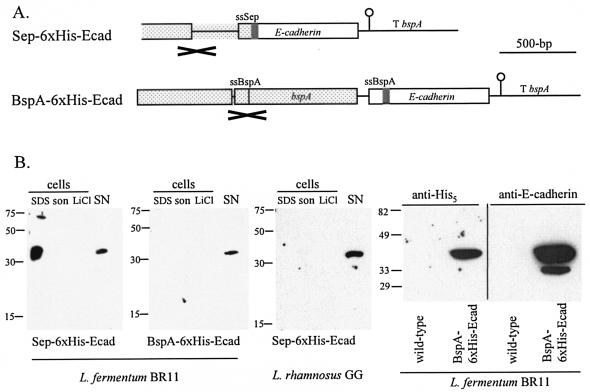FIG. 4.
Expression and secretion of a human E-cadherin fusion protein by L. fermentum BR11 and L. rhamnosus GG. (A) Arrangement of the constructs which were introduced into L. fermentum or L. rhamnosus. The bspA terminator (T bspA) and DNA encoding the Sep secretion signal (ssSep), BspA secretion signal (ssBspA), and His6 (grey box) are indicated. The DNA region which is the site of single-crossover homologous recombination into either the sep or bspA loci of L. fermentum BR11 is spotted and is marked with a cross below. (B) Western blots of fusion proteins in cell extracts and in the supernatant using an anti-His5 antibody, except for the rightmost blot for which an anti-E-cadherin antibody was used. The strains and constructs are indicated at the bottom of each blot. The sizes of the molecular mass markers are indicated on the left. The lanes containing cell extracts prepared by boiling in 2× SDS-loading dye (SDS), by sonication (son), and with 5 M LiCl (LiCl) and the precipitated supernatant fractions (SN) are indicated. The amounts of cells or medium loaded in each lane are the equivalent to 500 μl (SDS), 50 μl (son), 160 μl (LiCl), and 675 μl (SN) of culture. For the two rightmost blots, the equivalent of 1.2 ml of culture supernatant from L. fermentum (wild-type) or L. fermentum containing BspA-6xHis-Ecad (BspA-6xHis-Ecad) was loaded in each lane.

